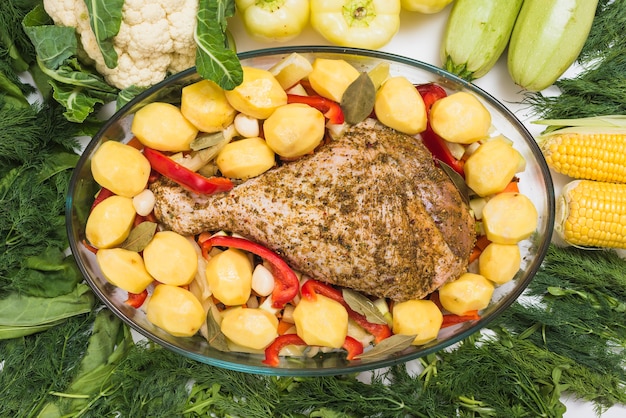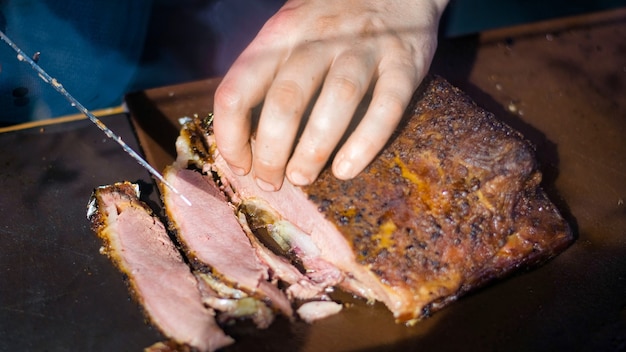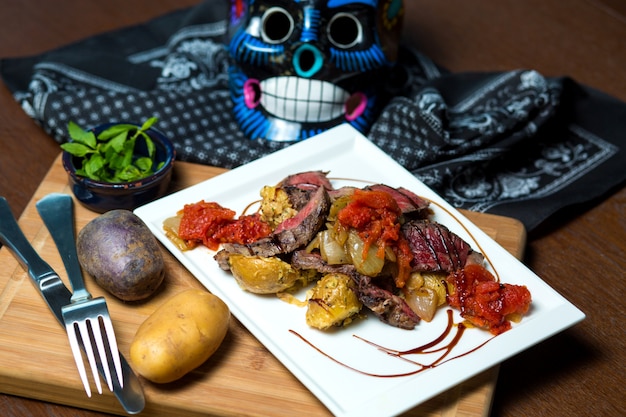Ah, corned beef. That salty, succulent, intensely flavoured cut of beef that practically begs to be roasted to absolute perfection. You know, the kind that fills your kitchen with mouthwatering aromas and brings a smile to everyone's face? Now, I'm not talking about those pre-packaged corned beef slices you find in the supermarket. I'm talking about the real deal, a big, beautiful chunk of beef that's been brined to a salty, meaty glory. And trust me, once you've tasted a properly cooked corned beef roast, you'll never go back.
I've been making corned beef roasts for years, experimenting with different cooking methods and techniques. I've learned a thing or two along the way, let me tell you. So, if you're looking for the ultimate guide to cooking the perfect corned beef roast, you've come to the right place. I'm going to walk you through every step, from selecting the right cut of meat to serving up a delicious, satisfying meal. Let's get started!
(Part 1) choosing the right cut

Understanding the Different Cuts
First things first, you need to pick the right cut of beef. You want something that's going to be tender and juicy after roasting. My go-to cut is the brisket. It's a tough cut of meat, but the long cooking time of a roast breaks it down beautifully, resulting in melt-in-your-mouth tenderness. You can also use chuck roast, which is a bit leaner than brisket, but still yields delicious results. It's all about finding your preference!
Now, some folks might suggest using a flat cut brisket, but honestly, I prefer the point cut. It's more marbled, which means it'll have more fat to render during cooking, resulting in a richer flavour and extra juiciness. It's the fat that gives you that delicious, buttery texture, and I'm all for that!
Looking for the Right Marbling
When you're selecting your corned beef, look for a cut that has good marbling. Marbling refers to the streaks of fat throughout the meat. You'll see it as those little white flecks, kind of like a marbled countertop. The fat adds flavour and juiciness to the roast as it renders during cooking. So, don't be afraid of a little bit of fat; it's your friend! The more marbling, the better!
Checking for Quality
Finally, make sure your corned beef is fresh and high quality. Look for a bright red colour, a firm texture, and no signs of discolouration or odour. You should be able to smell that delicious, salty aroma too. If you're unsure, don't hesitate to ask your butcher for advice. They'll be happy to help you choose the perfect cut.
(Part 2) Preparing the Corned Beef

Now that you've got your prime cut of corned beef, it's time to prep it for roasting. Here's how to do it like a pro.
Rinsing the Beef
The first step is to rinse the corned beef thoroughly under cold running water. This will remove any excess salt and brine that's been added during the curing process. Don't worry, though, it won't wash away all the delicious flavour! It's like giving it a quick shower before it gets dressed up for its grand roast.
Patting Dry
After rinsing, pat the corned beef dry with paper towels. This will help to ensure that the meat browns evenly in the oven. A nice, dry surface means a beautiful, crispy crust. You want a golden-brown exterior, right?
Removing the Packaging
If your corned beef came with a spice packet or a netting, remove it before roasting. The spices can burn in the oven and the netting can hinder the browning process. You'll also want to remove any fat that's accumulated on the surface of the meat. This fat will melt and render during cooking, so it's best to remove it beforehand. Think of it as giving the corned beef a fresh start!
(Part 3) Seasoning the Corned Beef

Now for the fun part: adding flavour! There are endless possibilities when it comes to seasoning your corned beef, but here are some of my favourites.
Classic Seasoning
For a classic corned beef roast, simply sprinkle the meat with a generous amount of black pepper and a pinch of garlic powder. You can also add a bay leaf or two for extra flavour. It's a simple, yet classic combination that never fails to impress.
Herby Seasoning
For a more herbaceous flavour, try rubbing the corned beef with a mixture of dried herbs, such as rosemary, thyme, and oregano. You can also add a few cloves of garlic, minced or crushed, for a touch of pungency. This option adds a fresh, earthy dimension to the corned beef.
Spiced Seasoning
If you like things a bit spicier, try adding a pinch of cayenne pepper or red pepper flakes to your seasoning mix. You can also experiment with other spices, like cumin, coriander, or paprika. Just be careful not to go overboard, you don't want to overwhelm the natural flavour of the corned beef.
(Part 4) Roasting the Corned Beef
Alright, time to get down to business! The roasting process is where the magic truly happens.
Preheat the Oven
First, preheat your oven to 325°F (160°C). This ensures that the corned beef cooks evenly and develops a beautiful crust. It's like giving the oven a little head start to make sure it's ready to embrace the corned beef.
Prepare the roasting pan
Place your corned beef in a large roasting pan. Add a cup or two of water to the bottom of the pan to help create steam and prevent the meat from drying out. This is like creating a little oasis for your corned beef to cook in, ensuring it stays moist and tender.
Roast the Beef
Place the roasting pan in the preheated oven and roast for 3-4 hours, or until the corned beef reaches an internal temperature of 190°F (88°C). The cooking time will vary depending on the size of your roast, so be sure to check the internal temperature with a meat thermometer. Don't be afraid to let it cook a little longer if needed, but be careful not to overcook it.
(Part 5) Resting the Corned Beef
Once the corned beef is cooked, it's essential to let it rest for at least 30 minutes before carving. This allows the juices to redistribute throughout the meat, resulting in a more tender and juicy roast. It's like giving the corned beef a little time to relax and savor its success.
Covering the Beef
Cover the corned beef loosely with aluminium foil and let it rest on a cutting board or in the roasting pan. This will help to keep the meat warm and prevent it from drying out. It's like wrapping it in a warm blanket to keep it cozy and comfortable.
Internal Temperature
While the beef is resting, you can check the internal temperature again. It should remain at least 160°F (71°C). If it's dropped below that, you can place the roasting pan back in the oven for a few minutes to reheat it. This is just a safety check to ensure the corned beef is still perfectly cooked.
(Part 6) Carving the Corned Beef
After the corned beef has rested, it's time to carve it up. Now, this is where things can get a little tricky, so take your time and be patient.
Cutting Against the Grain
The most important thing is to cut against the grain of the meat. This will make the meat easier to chew and more tender. You can tell the grain of the meat by looking for the muscle fibers, which run in a specific direction. You want to cut perpendicular to those fibers. Think of it like cutting across the threads of a fabric, making it easier to separate.
Using a Sharp Knife
Use a sharp knife to slice the corned beef. A dull knife will tear the meat and make it look messy. A sharp knife is your secret weapon for achieving perfectly sliced corned beef. If you're not comfortable carving the corned beef yourself, you can always ask your butcher to do it for you. They'll be happy to help!
(Part 7) Serving the Corned Beef Roast
Finally, it's time to serve up your delicious corned beef roast. Here are a few ideas for making it a truly memorable meal.
Classic Sides
Some classic sides that pair beautifully with corned beef include:
- mashed potatoes: Creamy, fluffy, and comforting, mashed potatoes are a perfect complement to the salty, savory corned beef. The richness of the potatoes balances out the saltiness of the corned beef, creating a heavenly taste combination.
- Cabbage: Braised or boiled cabbage, seasoned with a bit of salt and pepper, is a traditional side dish for corned beef. The cabbage's mild flavour provides a nice contrast to the bold flavour of the corned beef.
- Carrots: Roasted or glazed carrots add a touch of sweetness and colour to your plate. The sweetness of the carrots plays off the saltiness of the corned beef, making it a delightful and balanced dish.
- Pickles: A tangy side of pickles, like dill pickles or sweet gherkins, cuts through the richness of the corned beef. The acidity of the pickles helps to cleanse the palate, making you crave another bite of corned beef.
Creative Sides
For a more adventurous approach, try these creative side dishes:
- roasted brussels sprouts: Roasted with bacon and a sprinkle of balsamic vinegar, these sprouts are a delicious and healthy option. The smoky flavour of the bacon and the tangy balsamic vinegar complement the corned beef beautifully.
- sweet potato casserole: A creamy, sweet potato casserole with a crunchy pecan topping is a decadent and satisfying side. The sweet and creamy casserole provides a wonderful contrast to the salty corned beef.
- Cornbread: A crumbly cornbread, especially when served with a pat of butter, complements the corned beef beautifully. The cornbread's texture and flavour add a satisfying element to the meal.
- green bean casserole: A classic for a reason, green bean casserole is a delicious side that's both comforting and satisfying. The creamy sauce and crunchy fried onions provide a delightful combination of textures and flavours.
Sauces and Gravies
To elevate your corned beef roast to new heights, try serving it with a sauce or gravy. Here are a few options:
- Pan gravy: Made from the drippings in the roasting pan, this gravy is rich and flavourful. Simply whisk in flour and water, bring to a simmer, and cook until thickened. This is the ultimate way to capture the essence of the corned beef and create a truly decadent sauce.
- Horseradish sauce: This tangy sauce adds a kick of heat to the corned beef. Simply combine horseradish, mayonnaise, and a bit of lemon juice. This is a classic pairing for corned beef, adding a touch of spice and sharpness to the meal.
- Mustard sauce: A simple mustard sauce made with Dijon mustard, honey, and a bit of lemon juice adds a touch of sweetness and acidity to the corned beef. This sauce balances the saltiness of the corned beef with a touch of sweetness and a bright acidity.
(Part 8) Leftovers and Storage
You'll probably have some leftover corned beef roast, which is a good thing! It's just as delicious the next day (and even the day after that!).
Storing the Leftovers
Store the leftover corned beef in an airtight container in the refrigerator for up to 4 days. You can also freeze it for up to 3 months. To freeze, wrap the corned beef tightly in plastic wrap and then place it in a freezer-safe bag. This way you can enjoy your corned beef roast for days, or even weeks, to come.
Reheating the Leftovers
To reheat the corned beef, you can use the oven, stovetop, or microwave. The best method depends on how much you're reheating and how much time you have. You can reheat it slowly in the oven for a more even heat distribution, or quickly on the stovetop for a convenient option. The microwave is good for a quick reheating, but it might not be as flavourful as the other methods.
(Part 9) Serving Suggestions
Here are some delicious ways to use your leftover corned beef:
- corned beef sandwiches: Slice the corned beef thin and pile it onto toasted bread with mustard, sauerkraut, and a dill pickle. It's a classic for a reason. The tangy sauerkraut and crunchy pickle add a delightful complexity to the sandwich.
- Corned Beef Hash: Chop up the corned beef and sauté it with onions, potatoes, and peppers. It's a hearty and satisfying breakfast or brunch dish. The potatoes and peppers add a beautiful colour and texture contrast to the corned beef.
- corned beef soup: Add the corned beef to a pot of vegetable broth, along with potatoes, carrots, and celery, for a delicious and filling soup. The vegetable broth adds a lightness to the soup, while the potatoes, carrots, and celery provide a satisfying base.
- Corned Beef Salad: Dice the corned beef and combine it with shredded cabbage, carrots, and a tangy dressing. It's a refreshing and light meal. The shredded cabbage and carrots add a refreshing crunch to the salad, while the dressing adds a delightful tanginess.
(Part 10) FAQs
Here are some frequently asked questions about cooking corned beef roast:
1. Can I cook corned beef from frozen?
While it's possible to cook corned beef from frozen, it's not recommended. The meat may not cook evenly, and the texture can be tough. It's best to thaw the corned beef completely before cooking. This ensures that the corned beef cooks evenly and reaches the correct temperature throughout.
2. Can I use a slow cooker for corned beef?
Yes, you can cook corned beef in a slow cooker. Simply place the corned beef in the slow cooker with a cup or two of water and cook on low for 8-10 hours, or on high for 4-6 hours. However, keep in mind that you might not get as crispy a crust as you would with roasting. The slow cooker will create a tender and flavorful corned beef, but it won't develop the crispy crust you get from roasting.
3. What's the best way to reheat corned beef?
The best way to reheat corned beef is in the oven. Place the leftover corned beef in a baking dish and heat it in a preheated oven at 350°F (175°C) for 15-20 minutes, or until heated through. You can also reheat it on the stovetop in a skillet over medium heat. The oven method provides the most even reheating, while the stovetop method is faster and allows you to add a little extra flavour.
4. What happens if I overcook corned beef?
Overcooked corned beef can become dry and tough. If you're worried about overcooking the corned beef, you can use a meat thermometer to monitor the internal temperature. Make sure the internal temperature reaches 190°F (88°C) for optimal tenderness. Overcooked corned beef will have a rubbery texture, so it's best to stick to the recommended cooking time and temperature.
5. What's the best way to store leftover corned beef?
Store leftover corned beef in an airtight container in the refrigerator for up to 4 days. You can also freeze it for up to 3 months. To freeze, wrap the corned beef tightly in plastic wrap and then place it in a freezer-safe bag. Proper storage ensures that your corned beef stays fresh and flavorful, allowing you to enjoy it for a longer period.
There you have it, my friends! This is my ultimate guide to cooking the perfect corned beef roast. With a little bit of effort and these tips, you can create a truly unforgettable meal that will have everyone singing your praises.
Everyone is watching

Corn on the Cob: The Ultimate Guide to Perfectly Cooked Ears
Healthy MealsAh, corn on the cob. Just the name evokes images of sunny days, barbecues, and that sweet, juicy flavour that ...

Scallops: The Ultimate Guide to Perfect Cooking
Healthy MealsAh, scallops. Those delicate, sweet, and utterly delicious morsels of the sea. They hold a special place in my...

Spaghetti Squash: The Ultimate Guide to Cooking and Serving
Healthy MealsRemember that time you saw spaghetti squash at the supermarket, looking all bumpy and strange, and thought, "W...

Salmon Cooking Times: Perfect Guide for Every Recipe
Healthy MealsLet me tell you, cooking salmon is an art form. It's all about getting that perfect balance: juicy and tender,...

Ham Cooking Time: How Long to Bake, Smoke, or Boil a Delicious Ham
Healthy MealsAh, ham. It's a classic, isn't it? A real crowd-pleaser, especially around holidays. And when done right, it'...
